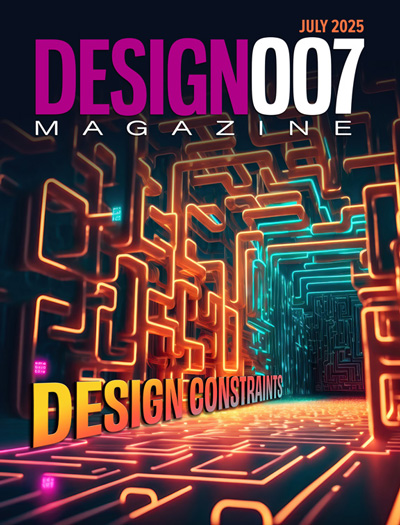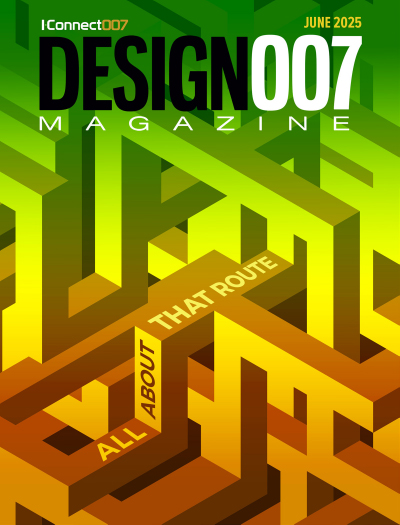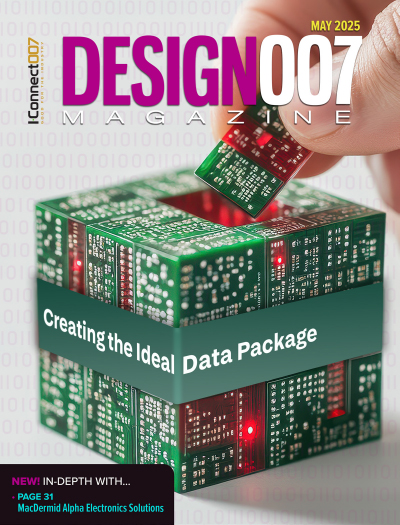-

- News
- Books
Featured Books
- design007 Magazine
Latest Issues
Current Issue
Showing Some Constraint
A strong design constraint strategy carefully balances a wide range of electrical and manufacturing trade-offs. This month, we explore the key requirements, common challenges, and best practices behind building an effective constraint strategy.

All About That Route
Most designers favor manual routing, but today's interactive autorouters may be changing designers' minds by allowing users more direct control. In this issue, our expert contributors discuss a variety of manual and autorouting strategies.

Creating the Ideal Data Package
Why is it so difficult to create the ideal data package? Many of these simple errors can be alleviated by paying attention to detail—and knowing what issues to look out for. So, this month, our experts weigh in on the best practices for creating the ideal design data package for your design.
- Articles
- Columns
- Links
- Media kit
||| MENU - design007 Magazine
Beyond Design: Stackup Planning, Part 4
November 19, 2015 | Barry Olney, In-Circuit DesignEstimated reading time: 1 minute
In this final part of the Stackup Planning series, I will look at 10-plus layer counts. The methodology I have set out in previous columns can be used to construct higher layer-count boards. In general, these boards contain more planes and therefore the issues associated with split power planes can usually be avoided. Also, 10-plus layers require very thin dielectrics in order to reduce the total board thickness. This naturally provides tight coupling between adjacent signal and plane layers reducing crosstalk and electromagnetic emissions.
In high-speed digital designs, transient ground currents are the primary source of both unwanted noise voltages and radiated emissions. In order to minimize these emissions, the impedance of the ground should be minimized by reducing the inductive loop area. Inductance is directly proportional to the length of the conductor, so keep the loop area as short as possible.
To minimize inductance, two conductors (signal traces or ground planes) that carry current in the same direction should be separated. However, two conductors that carry current in the opposite direction (such as signal and ground planes or power and ground planes) should be positioned as closely as possible. Both these cases also help eliminate crosstalk.
Here are some additional rules for high-speed design:
- Use multiple ground planes, where possible, rather than power planes, in the stackup to isolate signal layers.
- Place stitching ground vias close to every signal transition (via) to provide a short current return path.
- Spread numerous ground stitching vias around the board to connect the multiple ground planes through a low impedance path.
- Don’t use ground pours on signal layers as this reduces the impedance of nearby traces. If you must, in order to balance copper, separate the signal and pour by 20 mils.
If power planes are used as reference planes, then the return current must transverse stitching capacitors in order to jump between ground and power planes. The current flowing through these stitching capacitors will create a voltage drop across them. These voltages may radiate adding to system noise problems.
To read this entire column, which appeared in the October 2015 issue of The PCB Design Magazine, click here.
Testimonial
"In a year when every marketing dollar mattered, I chose to keep I-Connect007 in our 2025 plan. Their commitment to high-quality, insightful content aligns with Koh Young’s values and helps readers navigate a changing industry. "
Brent Fischthal - Koh YoungSuggested Items
Statement from the Global Electronics Association on the July 2025 Tariff on Copper Foil and Electronics-Grade Copper Inputs
07/31/2025 | Global Electronics AssociationWe are disappointed by today’s decision to impose a 50% tariff on imported copper foil and other essential materials critical to electronics manufacturing in the United States.
Considering the Future of Impending Copper Tariffs
07/30/2025 | I-Connect007 Editorial TeamThe Global Electronics Association is alerting industry members that a potential 50% tariff on copper could hit U.S. electronics manufacturers where it hurts.
Connect the Dots: Sequential Lamination in HDI PCB Manufacturing
07/31/2025 | Matt Stevenson -- Column: Connect the DotsAs HDI technology becomes mainstream in high-speed and miniaturized electronics, understanding the PCB manufacturing process can help PCB design engineers create successful, cost-effective designs using advanced technologies. Designs that incorporate blind and buried vias, boards with space constraints, sensitive signal integrity requirements, or internal heat dissipation concerns are often candidates for HDI technology and usually require sequential lamination to satisfy the requirements.
OKI Launches Rigid-Flex PCBs with Embedded Copper Coins Featuring Improved Heat Dissipation for Space Equipment Applications
07/29/2025 | BUSINESS WIREOKI Circuit Technology, the OKI Group’s printed circuit board (PCB) business company, has developed rigid-flex PCBs with embedded copper coins that offer improved heat dissipation for use in rockets and satellite-mounted equipment operating in vacuum environments.
Designers Notebook: Basic PCB Planning Criteria—Establishing Design Constraints
07/22/2025 | Vern Solberg -- Column: Designer's NotebookPrinted circuit board development flows more smoothly when all critical issues are predefined and understood from the start. As a basic planning strategy, the designer must first consider the product performance criteria, then determine the specific industry standards or specifications that the product must meet. Planning also includes a review of all significant issues that may affect the product’s manufacture, performance, reliability, overall quality, and safety.


